Fatty Acids: Types
- Triglycerides are a form of lipid, made up of one molecule of glycerol with three fatty acids attached to it
- These fatty acids have long hydrocarbon ‘tails’
- Fatty acids occur in two forms:
- Saturated fatty acids
- Unsaturated fatty acids
- Unsaturated fatty acids can be monounsaturated or polyunsaturated
Saturated fatty acids
- In saturated fatty acids, the bonds between the carbon atoms in the hydrocarbon tail are all single bonds
- The fatty acid is said to be ‘saturated’ with hydrogen
- This means that each carbon atom in the hydrocarbon tail (except for the final carbon atom) is bonded to two hydrogen atoms
- Saturated fatty acids can be synthesised industrially by hydrogenation (reaction with hydrogen gas) of unsaturated fatty acids
- All the carbon-to-carbon bonds are single bonds in saturated fatty acids
![[Saturated fatty acid example.png], downloadable AS & A Level Biology revision notes](../../../../../../../../cdn-cgi/image/w%3D1920%2Cf%3Dauto/uploads/2021/02/Saturated-fatty-acid-example-1.png)
An example of a saturated fatty acid
Unsaturated fatty acids
- In unsaturated fatty acids, the bonds between the carbon atoms in the hydrocarbon tail are not all single bonds
- There is at least one carbon-carbon double bond; a fatty acid with one C=C double bond is known as monounsaturated fatty acid
- In some unsaturated fatty acids, there are many carbon-carbon double bonds; these are known as polyunsaturated fatty acids
- These double bonds can cause the hydrocarbon tail of unsaturated fatty acids to kink (bend slightly), meaning they are not as straight as saturated fatty acids
- The fatty acid is said to be ‘unsaturated’ because the hydrocarbon tail does not contain the maximum number of hydrogen atoms possible
- This is because each carbon atom in a carbon-carbon double bond can only bond to one hydrogen atom (instead of two)
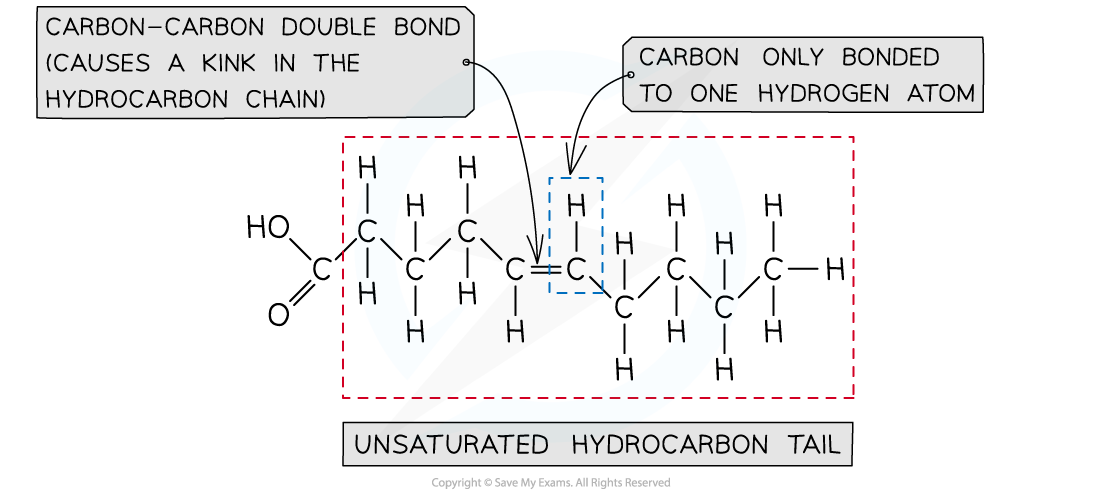
An example of a monounsaturated fatty acid
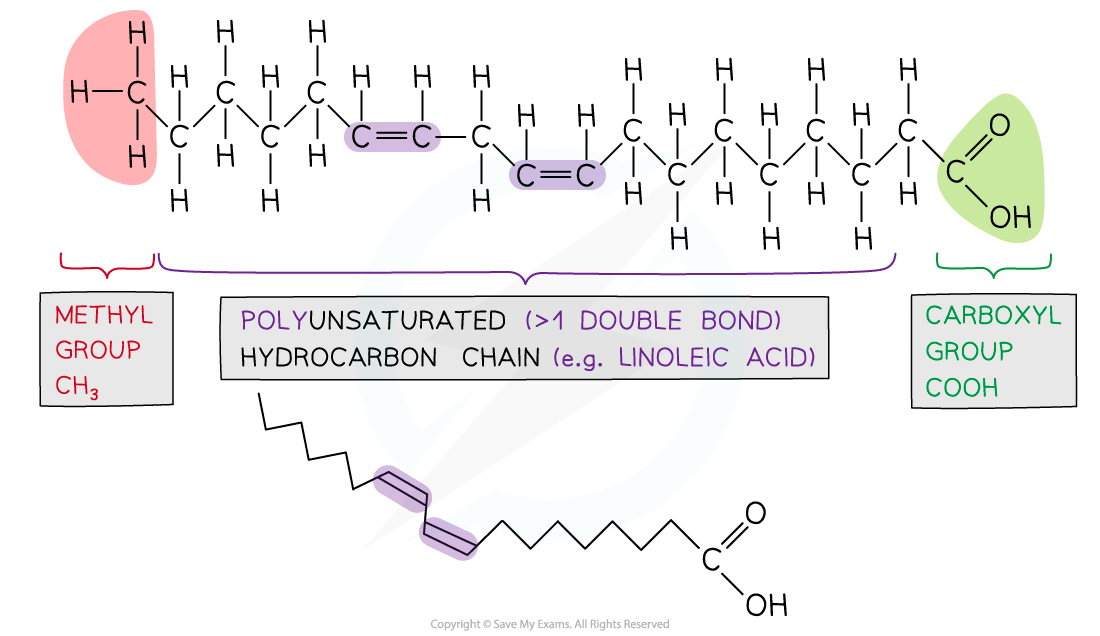
An example of a polyunsaturated fatty acid
Exam Tip
You don't need to know the names of various fatty acids, but you should be able to recognise from a diagram whether a fatty acid is saturated, monounsaturated or polyunsaturated (look for any carbon-carbon double bonds)!
Unsaturated Fatty Acids
The different isomers of unsaturated fatty acids
- A single C-C bond in a hydrocarbon chain is able to rotate along its axis so that rotation of one part of the molecule in relation to others is possible
- The rotation may cause conformational changes in molecules but they all remain identical
- However, when there is a C=C double bond in a hydrocarbon chain, no rotation is possible
- This causes isomers of fatty acids to be formed, each with different properties
- The isomers are labelled cis and trans isomers
Cis-isomers
- At a C=C double bond, the attached hydrogen atoms are on the same side of the hydrocarbon chain as each other
- This causes a kink in the fatty acid chain which means the fatty acid chains are less tightly packed together, lowering their melting point (less kinetic energy is needed to break them apart)
- Triglycerides that contain cis-unsaturated fatty acids are liquid (oils) at room temperature
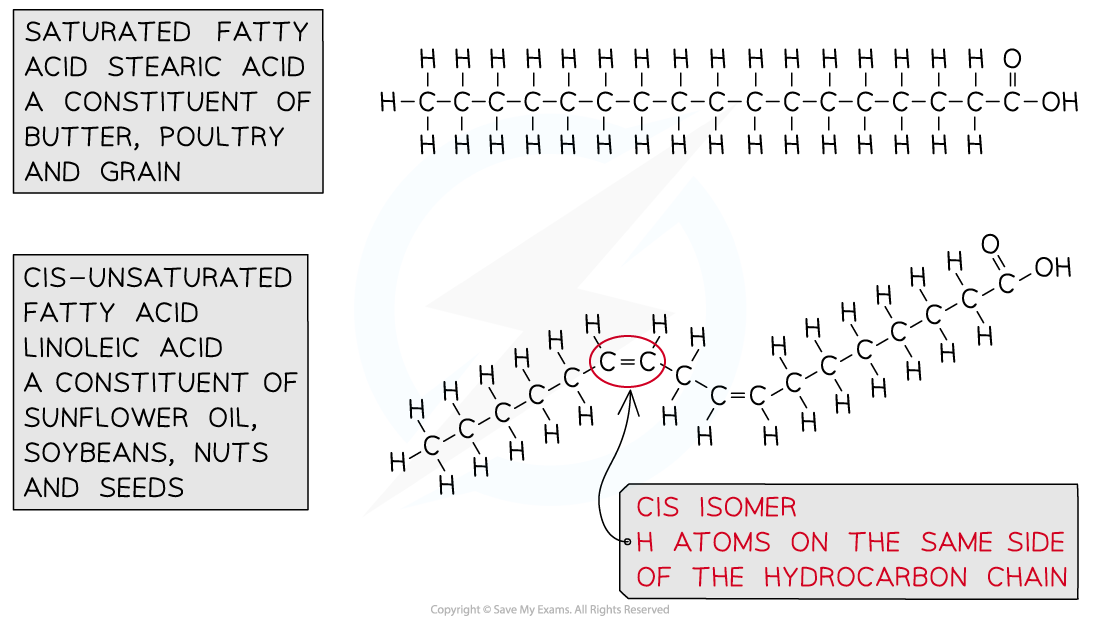
The Structural Differences Between a Saturated and a Cis-Unsaturated Fatty Acid
Trans-isomers
- At a C=C double bond, the attached hydrogen atoms are on the opposite sides of the hydrocarbon chain to each other
- The lack of bend in the hydrocarbon chain allows them to pack more closely together meaning they have a higher melting point (this property makes them more attractive to food manufacturers)
- Triglycerides that contain trans-saturated fatty acids are solid are room temperature
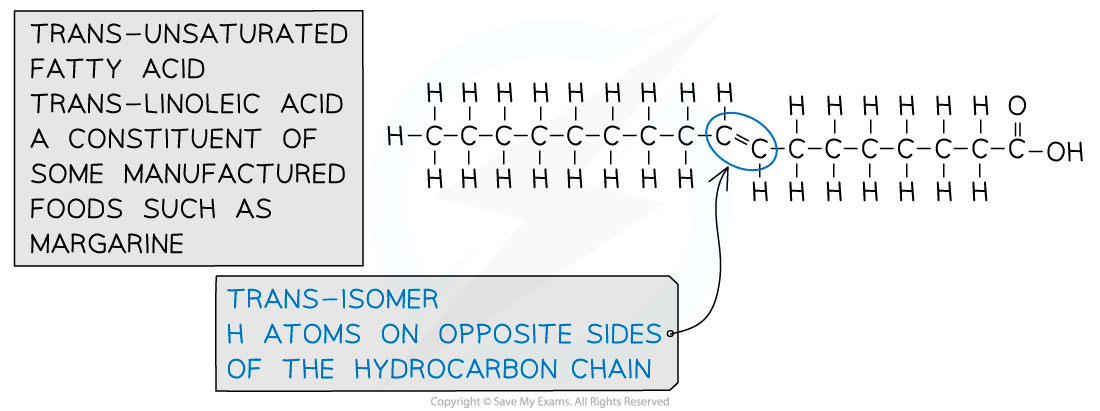
The Structure of a Trans-Unsaturated Fatty Acid
Fatty Acids: Health Risks
The use of trans-fatty acids in the food industry
- Trans-fatty acids occur in small quantities in natural products such as dairy and red meat
- Artificial trans-fats (which contain trans-fatty acids) are made industrially by the hydrogenation of liquid vegetable oils
- Trans-fats are favoured by food manufacturers for commercial reasons
- They are more solid at room temperature
- They create more stable emulsions in shortening agents
- Food products with trans-fats appear (in their retail packaging) drier and less 'greasy' to consumers
- Alleged taste benefits (though this is subjective)
- They can be reused more times eg. in large-scale deep-fat fryers
- Many countries have legislated to restrict the use of trans-fats in the foodservice industry
- Many foods that contains trans-fats (often labelled as 'partially hydrogenated vegetable oils') are sold as processed products in supermarkets
- Biscuits/cookies
- Cakes
- Doughnuts
- Pie crusts
- Crisps
- Pizza bases
- Certain kinds of margarine and spreads
Trans-fatty acids have associated health risks
- The two types of fat that lead to health problems are namely saturated fats and trans-fats
- Doctors recommend limiting your intake of these types of fats
- Trans-fats alter the balance of various types of cholesterol
- They increase low-density lipoprotein (LDL) levels in circulation (so-called 'bad' cholesterol)
- They decrease high-density lipoprotein (HDL) levels in circulation (so-called 'good' cholesterol)
- LDLs are known to increase the risk of coronary heart disease, blood clotting and strokes
- Doctors recommend that the bulk of fats intake should come from monounsaturated fats, which reduce LDL levels
- Omega-3 fats and oils are a well-publicised source of monounsaturated fats; these are found in fish, pulses and certain nuts
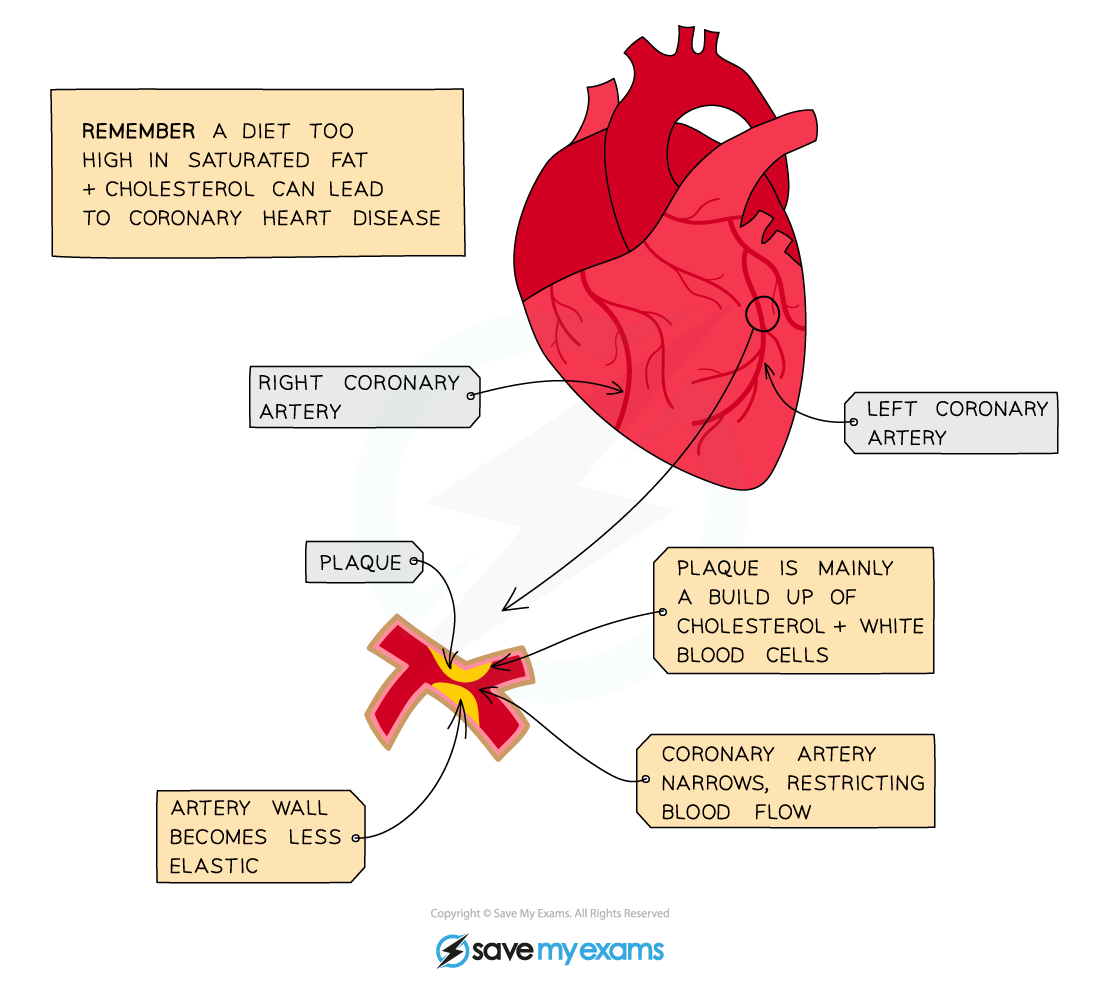 Excess consumption of trans-fatty acids and saturated fats can lead to the buildup of cholesterol and the blockage of coronary arteries, causing Coronary Heart Disease (CHD)
Excess consumption of trans-fatty acids and saturated fats can lead to the buildup of cholesterol and the blockage of coronary arteries, causing Coronary Heart Disease (CHD)
Evaluating claims
- Evidence for the claims surrounding the health risks associated with trans-fats often comes from 'cohort studies'
- Eg. Greenland Eskimos, whose diet is rich in oily fish and meat, have a very low incidence of heart disease
- Other epidemiological studies can establish correlations between diet and incidence of disease
- Whilst it is rare to find a direct causal link between fat intake and heart disease, the many claims about fats suggest strongly that trans-fats have an overall detrimental effect on health when consumed in high quantities
- Other conditions linked to trans-fats include
- Allergy
- Breast cancer
- Colonic cancer
- Cardiovascular diseases
- Premature birth
- Preeclampsia (a condition associated with pregnancy)
- Disorders of the nervous system
- Vision defects in infants
- Diabetes
- Obesity
Exam Tip
- It is important to remember that correlation does not always mean causation
- Correlation is an association or relationship between variables
- Causation occurs when one variable has an influence or is influenced by, another
- There is a clear distinction between correlation and causation: a correlation does not necessarily imply a causative relationship
